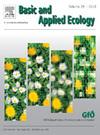Survival patterns and population stability of cliff plants suggest high resistance to climatic variability
IF 3.5
2区 环境科学与生态学
Q2 ECOLOGY
引用次数: 0
Abstract
Cliffs are marginal and poorly studied habitats that are home to a high proportion of endemic or threatened species. Here, we reviewed the survival patterns and population dynamics of plants growing on vertical cliffs and compared them to other plants with similar life forms that grow on the ground. To this end, we have compiled studies of cliff and ground-level plants from two main sources: MONITO and COMPADRE. The resulting dataset after applying some filters included a total of 243 populations of 134 plant species monitored for several years in the northern hemisphere. We tested whether survival rates of seedlings and older stages, population growth rates, and their temporal variability showed similar patterns between cliff and ground plants, and the relationship between those demographic parameters. Cliff plants showed higher survival rates for both seedlings and older life stages, as well as lower distance to population equilibrium and more stable population trends over time, compared to plants growing in the ground. Population equilibrium and temporal stability was highly correlated with the survival of post-seedling stages in both groups. These results suggest that cliff plants may be better adapted to withstand climatic variability than the more common ground-level plants occurring in less stressful environments.
悬崖植物的生存模式和种群稳定性表明它们对气候变异具有很强的抵抗力
悬崖是一种边缘栖息地,对其研究较少,但却是大量特有或濒危物种的栖息地。在这里,我们回顾了生长在垂直悬崖上的植物的生存模式和种群动态,并将它们与生长在地面上的其他具有类似生命形式的植物进行了比较。为此,我们汇编了来自两个主要来源的悬崖植物和地面植物研究报告:MONITO 和 COMPADRE。经过筛选后得到的数据集包括在北半球监测多年的 134 种植物的 243 个种群。我们测试了悬崖植物和地面植物的幼苗和幼苗阶段的存活率、种群增长率及其时间变化是否呈现出相似的模式,以及这些人口统计参数之间的关系。与生长在地面上的植物相比,悬崖植物的幼苗和老龄生命阶段的存活率更高,距离种群平衡的距离更短,随着时间的推移,种群趋势更稳定。种群平衡和时间稳定性与两组中幼苗后阶段的存活率高度相关。这些结果表明,与更常见的生长在压力较小环境中的地面植物相比,悬崖植物可能更能适应气候的多变性。
本文章由计算机程序翻译,如有差异,请以英文原文为准。
求助全文
约1分钟内获得全文
求助全文
来源期刊

Basic and Applied Ecology
环境科学-生态学
CiteScore
6.90
自引率
5.30%
发文量
103
审稿时长
10.6 weeks
期刊介绍:
Basic and Applied Ecology provides a forum in which significant advances and ideas can be rapidly communicated to a wide audience. Basic and Applied Ecology publishes original contributions, perspectives and reviews from all areas of basic and applied ecology. Ecologists from all countries are invited to publish ecological research of international interest in its pages. There is no bias with regard to taxon or geographical area.
 求助内容:
求助内容: 应助结果提醒方式:
应助结果提醒方式:


